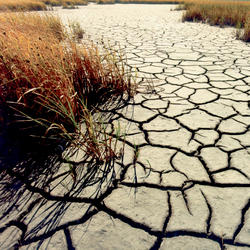Drought
Drought
Featured Project
Estimating the Future Effects of Forest Disturbance on Snow Water Resources in a Changing Environment
Estimating the Future Effects of Forest Disturbance on Snow Water Resources in a Changing Environment
Droughts of the future will be hotter, longer-lasting, and larger than droughts of the past. CASC-supported scientists are working to understand how changing drought conditions will impact important natural resources. Learn more about this work below.
Filter Total Items: 135
Developing and Testing a Drought Early Warning Product in the South-Central United States
Drought is a common result of climate variability in the south-central United States. With increasing temperatures and more variable precipitation patterns expected in the future, drought will continue to stress water quantity and quality in this region. University of Oklahoma researchers have demonstrated that the Palmer Drought Severity Index (PDSI), a measure of long-term drought conditions, ca
Improving Water Resilience and Availability Through Culturally Prescribed Fires as a Management Tool on Yurok Tribal Lands
Climate Change is making our environment unpredictable. Increased persistence of drought is causing deaths of plants and animals across our landscapes. However, drought amongst the western United States is not a new thing. Native American populations have been living with drought since time immemorial and practiced culturally prescribed fire practices to foster the landscape for an environment tha
Informing Mekong River Basin Resiliency and Climate Adaptation
CASC experts are often requested to provide technical assistance to other Federal agencies, including the U.S. Department of State, as well as national and international partners. The U.S. Consulate in Thailand solicited leadership and guidance from the CASCs to help develop community-supported recommendations for increasing resiliency for fishing communities in the Mekong River Basin. Thail
State of the Science in Streamflow Modeling in the North Central Region to Address Partner Needs for Water Availability Under Drought Conditions
Land and water managers often rely on hydrological models to make informed management decisions. Understanding water availability in streams, rivers, and reservoirs during high demand periods that coincide with seasonal low flows can affect how water managers plan for its distribution for human consumption while sustaining aquatic ecosystems. Substantial advancement in hydrological modeling has oc
The Implications of Stream Fragmentation for Climate Change Resilience of Northern Prairie Fishes
Dry stream sections are characteristic of most prairie streams. Native fish are highly adapted to variable environments, using refuge habitats (e.g., remaining wet stream fragments) to recolonize areas after seasonal drying. However, dams and other barriers can prevent recolonization of seasonally-dry stream sections habitats known to be critical spawning and rearing areas for many species. This p
Uniting Western Restoration Strategies and Traditional Knowledge to Build Community Capacity and Climate Resilience on the Navajo Nation
Across the Navajo Nation, the negative effects of climate change are impacting soil and vegetation management practices to the detriment of ecosystem function, human health, cultural resiliency, and economic well-being. Conducting ecosystem restoration and shifting land management practices are critical elements of climate adaptation and dust mitigation strategies for the Navajo Nation. However, b
Assessing Future Climate Impacts on Threatened and Endangered Groundwater Dependent Species in the Edwards Aquifer Region Using a Novel Hybrid Artificial Intelligence Framework
The Edwards Aquifer in south-central Texas provides water resources to more than 2 million people and is home to eight federally listed threatened and endangered species that are dependent on spring flow from the aquifer for survival. Recent results from global climate models indicate that over the next several decades increases in annual average temperatures and evapotranspiration are likely in
Estimating Future High-Mountain Snowpack to Inform Terrestrial and Aquatic Species Status Assessments, Recovery Plans, and Monitoring
One of the most visible signs of climate change is less mountain snow. In the Western U.S., deep snow has historically been a cornerstone of life for many plants and animals. For example, snow can provide denning shelter for certain species like the wolverine, and snowmelt provides dependable water to mountain streams that are home to fish like the bull trout. Yet snow losses driven by warming tem
Estimating the Future Effects of Forest Disturbance on Snow Water Resources in a Changing Environment
In the Western U.S., approximately 65% of the water supply comes from forested regions with most of the water that feeds local rivers coming from snowmelt that originates in mountain forests. The Rio Grande headwaters (I.e. the primary water generating region of the Rio Grande river) is experiencing large changes to the landscape primarily from forest fires and bark beetle infestations. Already, 8
A Climate Risk Management Screening and Assessment Review for Madagascar’s Country Development Cooperation Strategy
Madagascar, a country rich in natural capital and biodiversity but with high levels of poverty, food insecurity, and population growth, faces a number of development challenges, including obtaining sustained financial support from external sources and building internal capacity to address the poor environmental, health, and socio-economic conditions. Climate change poses an increasing threat to ac
A Climate-Informed Adaptation and Post-Fire Strategy for the Southwestern Region
The Southwest is projected to face significant climate challenges in coming decades; and many of these stresses have already begun. In recent years, multiple climate assessments have been developed for the Southwest that corroborate forecasts of remarkable change to vegetation pattern and the vulnerability of regional ecosystems and suggest that measurable change is already ongoing. Disturbance ev
A Climate-Informed Conservation Strategy for Southern California’s Montane Forests
California is a world biodiversity hotspot, and also home to hundreds of sensitive, threatened, and endangered species. One of the most vulnerable ecosystems in California is the “sky island” montane forests of southern California, forests of conifers and hardwoods located only in high-elevation mountain regions. Montane forests serve many important ecosystem functions, including protecting the up
















